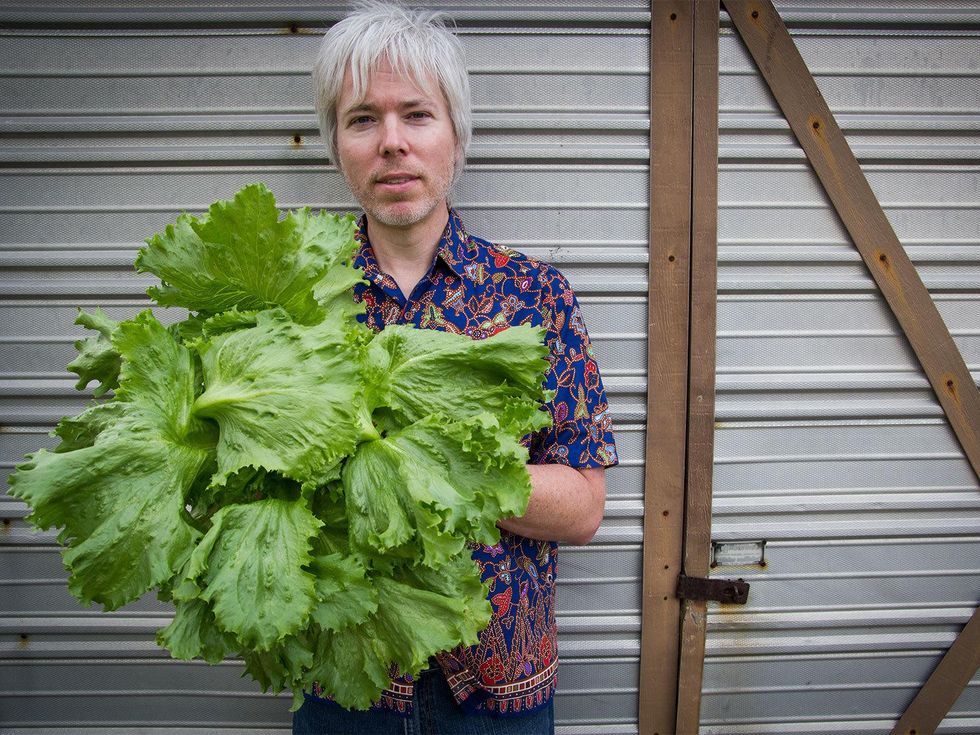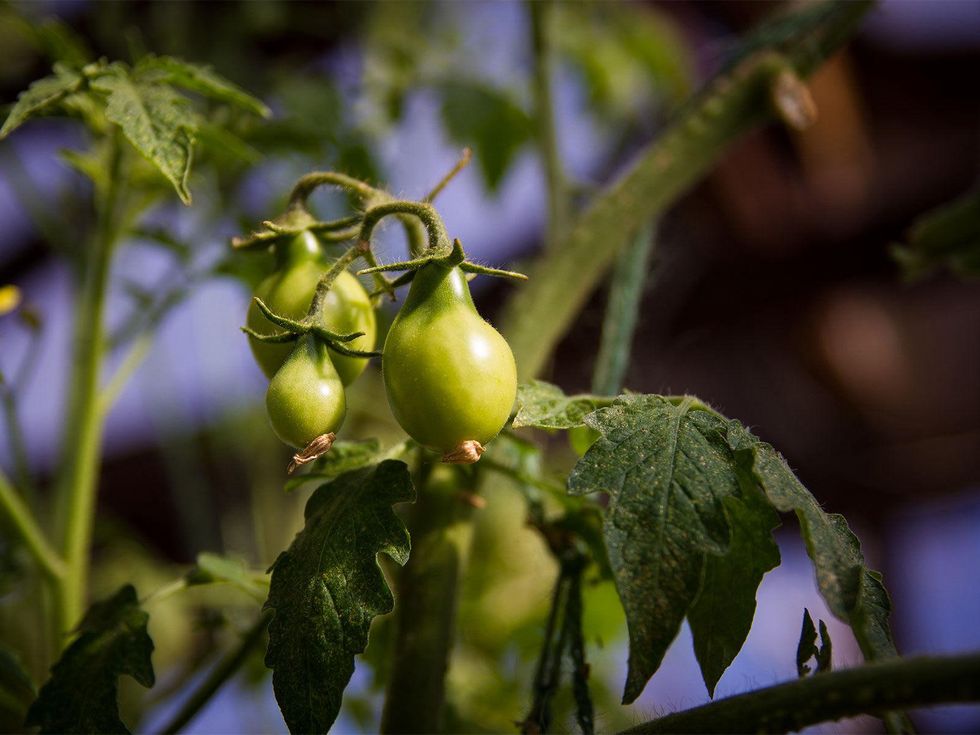The Farmer Diaries
Texas farmer ditches dirt to experiment with hydroponics
I was in my greenhouse last December, preparing seedlings for the new year, when I made a discovery that changed everything I thought about plants and food production.
Tucked behind some pots was a mason jar, coated with algae, holding a few sprigs of tomato plants I cut from my garden last fall. I had intended to root them and plant them in containers, but I forgot about them. Some of the sprigs had died. But one put on roots, grew up and out of the jar, and sprawled out onto the table.
The fact that this plant had survived in the face of utter neglect was impressive enough. But what startled me was the fact that the plant had a tomato growing at the end of the vine — red, ripe and ready for picking in the dead of winter.
Indoor hydroponic production reduces water needs by up to 90 percent, makes pesticide companies obsolete and frees us from climate challenges.
By accident, I'd witnessed an example of what professor and author Dickson Despommier says is the future of crop production in his 2010 book, The Vertical Farm. The book is not a guide of growing methods; rather, it's a proposal on how we can progress from land-based crops grown outdoors to crops grown indoors, in a controlled climate, where farmers harvest fruits and vegetables throughout the year, not just when a crop is in season.
Essential to this concept is hydroponics, the practice of growing plants in an aerated nutrient solution without dirt. The book, along with every study about hydroponics I've read, has persuaded me that we can grow more food on less land, using less energy, if we simply upgrade our growing methods.
The benefits are numerous. Indoor hydroponic production reduces water needs by up to 90 percent; makes pesticide companies obsolete; and frees us from climate challenges such as droughts, floods and unexpected freezes.
Hydroponics always intimidated me; all this science, I don't understand. But the mason jar tomato changed that. Putting vertical farming into practice successfully has become my obsession.
Growing a winter salad
I began by creating my own experimental hydroponic system. Using a bucket-stacking system similar to bokashi composting, I took two 5-gallon buckets and drilled holes in one. I filled the drilled basket with expanded shale, a gravel-like growing medium, then stacked it into the intact bucket. I planted a rooted tomato sprig in the top bucket, then poured in enough water to fill the lower bucket just up to the bottom of the upper bucket.
I rigged up a watering system, using a submersible electric bird-bath pump with flexible tubing that would draw water from the lower bucket and flow it out into the upper bucket. Once I plugged in the pump, it spurted up water from below and into the root zone of my transplant. To this water flow, I added plant nourishment: seaweed extract and a few teaspoons of liquid plant food.
Unlike plants planted in garden soil, the hydroponic tomato showed no signs of transplant shock. Rather than falling over limp for a few days after its roots were disturbed, it stood up straighter the next day. In a week, it bushed out and grew rapidly.
When I harvested my first head of lettuce in early March, I also harvested tomatoes, chard and a cucumber. In a controlled environment, it's a cinch.
But then its leaves began to look less verdant. Taking that as a sign of a deficiency, I added a nutrient concentrate produced by General Hydroponics (purchased at Lone Star Hydroponics in Dallas). After a day in the hydroponic solution, the tomato plant perked back up.
Lettuce pray
Because my experiment showed promise, I decided to try lettuce, a crop that has caused me great suffering in the garden.
Rather than buy a prefabricated hydroponic system, I made my own. I purchased a flat, wide, 28-quart Sterilite container — the kind you use to store sweaters under a bed — at Target for $5. I cut holes in the lid to hold six "net cups," about the size of a single-serving yogurt cup, with slots punched in them that allow plant roots to grow through them.
I sprouted some lettuce seeds on moist paper towels. Once they emerged as seedlings, I placed them into the net cups, with their roots dangling out of the bottom. I set the cups into the holes in the lid, letting them hang in place by their rims. Then I filled the tub with water and nutrients. To keep them aerated, I installed a $6 aquarium air pump with an air stone. Seventy five days later, I had six heads of iceberg lettuce.
In addition to the lettuce, I hydroponically planted yellow pear tomatoes, cucumber, Swiss chard and basil. When I harvested my first head of lettuce in early March, I also harvested tomatoes, chard and a cucumber. Topped with a sprinkling of homegrown alfalfa sprouts, it was the crunchiest, most flavorful salad I've eaten.
More than a salad, it was proof of the potential of hydroponics. Lettuce is a cool-season plant. Tomatoes are a summertime crop. Cucumbers and Swiss chard are best in the seasons in between. To harvest all simultaneously is seldom feasible in a Texas garden. But in a controlled environment, it's a cinch.
I have not found it necessary to supplement lighting, despite recommendations encouraging its use. Everything has grown well from the natural sunlight that falls into the 144 square-foot greenhouse in my backyard. It's one of the perks of living in Texas.
That I've had no plant casualties or setbacks has inflamed my obsession. Maintaining my commitment to eat only what I grow organically is a struggle in the winter. Half-sick of collard greens, kale, Swiss chard and other cold-hardy plants, I crave summer cucumbers, squash, okra and melons. The neglected tomato was an exciting omen.








 Earlier Luck on the Lawn event this year at the Hotel Magdalena.Photo from Hotel Magdalena
Earlier Luck on the Lawn event this year at the Hotel Magdalena.Photo from Hotel Magdalena Print press production at the Press Room at the Baker Center.Photo courtesy of the Baker Center
Print press production at the Press Room at the Baker Center.Photo courtesy of the Baker Center Creations by Colleen, one of the vendors at Holiday Artisan Market.Photo courtesy of Creations by Colleen
Creations by Colleen, one of the vendors at Holiday Artisan Market.Photo courtesy of Creations by Colleen Photos from the Merry Market Austin event in December 2024.Photo by Katlyn Gitzen. Graphics by Kate Donovan
Photos from the Merry Market Austin event in December 2024.Photo by Katlyn Gitzen. Graphics by Kate Donovan Bee Cave on Ice, sponsored by the City of Bee Caves, at the Hill Country Galleria.Photo courtesy of the City of Bee Cave
Bee Cave on Ice, sponsored by the City of Bee Caves, at the Hill Country Galleria.Photo courtesy of the City of Bee Cave Koko's Beer Hall will offer holiday-themed drinks this month to celebrate the holiday season.Photo by Chad Wadsworth
Koko's Beer Hall will offer holiday-themed drinks this month to celebrate the holiday season.Photo by Chad Wadsworth